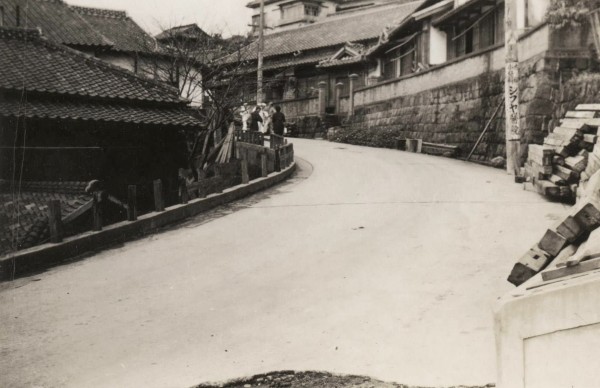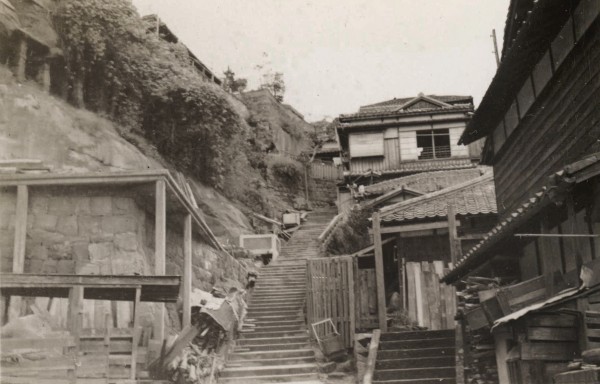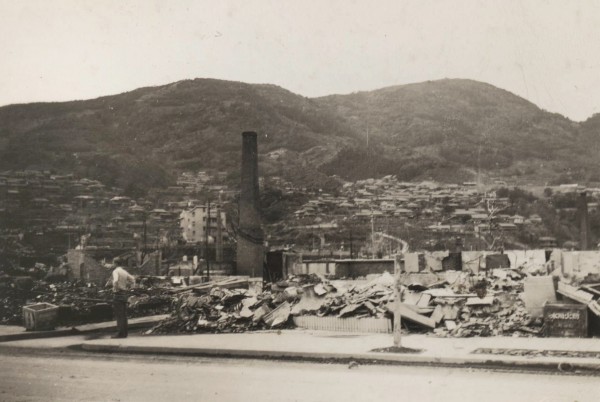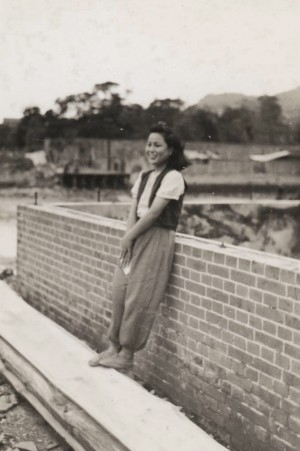Some months ago, I was contacted by a sailor who served aboard a sibling minesweeper across the American, European, and Pacific theatres of WWII. Lieutenant Marty Roberts of Raleigh, NC served aboard YMS-468 as Engineering Officer and later Deck Officer, from 1943 to 1946. Marty wrote up this biography of his naval service for his grandson and was kind enough to share it and his photographs with us.
This post is an eight-part series. Below is an index of all parts. Enjoy!
Marty Roberts of Raleigh, NC | February 28th, 2014
Navy Days – A Letter to Joe
- Part 1: In training
- Part 2: YMS-468 on the US East Coast
- Part 3: YMS-468 through Panama Canal, in prep for battle
- Part 4: YMS-468 on the US West Coast, into the Pacific Theatre
- Part 5: YMS-468 in battle, up to Japan’s surrender
- Part 6: YMS-468 in Makurazaki Typhoon
- Part 7: YMS-468 moored in Japan’s occupation
- Part 8: After the war
Part 7 of 8: YMS-468 moored in Japan’s occupation
The City of Sasebo was up at the head of the inner harbor about a mile from where we were and we soon went to see what it looked like. I do not recall seeing any appreciable damage there, but if you look at a map of Kyushu you will see that Nagasaki is just a short distance to the East where the second atomic bomb was dropped. I must give the Japanese people credit for accepting their defeat in good spirit because they obeyed the terms of surrender and did not give us any difficulty when we went ashore. Here are a couple of pictures taken in Sasebo.
Our next assignment was to go to the much larger city of Fukuoka on the Northwestern corner of Kyushu. This is a major seaport with a large harbor that handled substantial shipping and for that reason was a prime target of our air-force which pretty-much leveled the city with firebombs and laid many mines in the harbor. Our job was to clear these (our own) mines out of the harbor. I remember getting charts from the air force showing where they dropped the mines, but since they were dropped at night by parachute they noted the accuracy was +/– five miles! Totally useless info for our purposes, but judging from the number of Japanese merchant ships sitting on the bottom of the harbor the objectives were achieved. While there, I did get some pictures and you can see some of the damage to the city.
During this operation we moored at the city docks and each day went out the swept channel to continue clearing the harbor. One day on the way out, a Japanese fishing boat crossed our path to the starboard and I could see with the binoculars that he evidently was helping with the minesweeping because I could see hanging over his stern a bundle of what appeared to be large magnets attached to a line ready to be paid out and dragged along the bottom to detonate a magnetic mine. Unfortunately, he did not stream the gear soon enough and blew a mine right under him causing the whole boat to rise up into the air like a flying lumber yard!
After finishing our work at Fukuoka we returned to Sasebo. Arrangements had been made to take our ship and another YMS into a Japanese drydock for repairs.
Before our scheduled work came up, however, Dave Stafford our Exec had received orders to go home and his relief had no experience handling the ship. Al, our skipper, then got his orders to leave even without any replacement. As a consequence, Al and the men in the other ship were concerned about taking the two ships tied together into the drydock, so he decided I should be in charge of handling this and therefore changed my designation from E to DE and promoted me to Executive Officer. This is how I became both an Engineering and a Deck Officer. When the time came I took both ships in using the port engine of our ship and the starboard engine of the other ship. No trouble at all! The Japanese workmen were very good at getting all the chocks under the ships in the right place and there they were, high and dry.
This post is an eight-part series. Below is an index of all parts. Enjoy!
Marty Roberts of Raleigh, NC | February 28th, 2014
Navy Days – A Letter to Joe
- Part 1: In training
- Part 2: YMS-468 on the US East Coast
- Part 3: YMS-468 through Panama Canal, in prep for battle
- Part 4: YMS-468 on the US West Coast, into the Pacific Theatre
- Part 5: YMS-468 in battle, up to Japan’s surrender
- Part 6: YMS-468 in Makurazaki Typhoon
- Part 7: YMS-468 moored in Japan’s occupation
- Part 8: After the war




